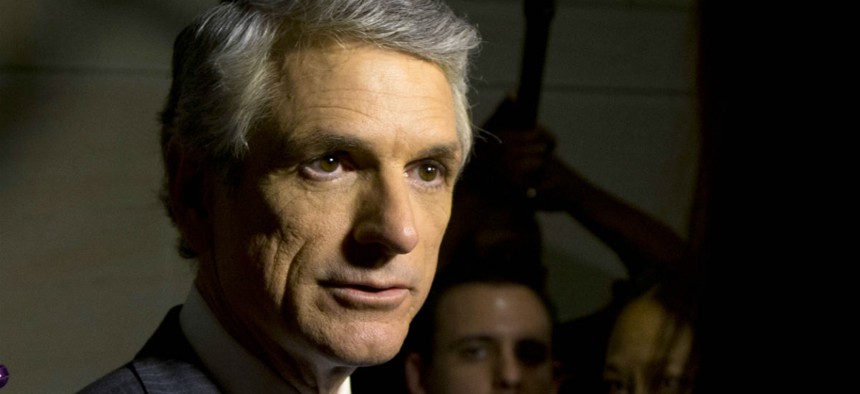
Rep. Scott Rigell, R-Va, introduced the bill. Carolyn Kaster/AP
Feds Would Pay More Toward Pensions Under Proposal
Bill that would ease pain of sequestration also would require many federal employees to contribute 4.4 percent of pay to retirement benefits.
Many federal employees would pay more toward their pension benefits under a new House bill aimed at providing relief from sequestration and protecting Medicare and Social Security.
Rep. Scott Rigell, R-Va., has introduced legislation that would restore 75 percent of the sequester spending cuts to defense and non-defense budgets with proposed savings and revenue elsewhere, including an increase in the amount of pay that federal employees hired before 2014 have to contribute to their pensions. Specifically, Rigell’s bill would apply the higher retirement contribution rates that federal employees hired in 2014 or later have to pay now to all federal workers under the Federal Employees Retirement System.
For many federal employees who currently contribute 0.8 percent, that would be a 3.6 percentage point increase per paycheck.
The 2013 Bipartisan Budget Act, crafted by Rep. Paul Ryan, R-Wis., and Sen. Patty Murray, D-Wash., required feds hired in 2014 and beyond to contribute 4.4 percent of their salaries to their pensions in FERS. Workers hired after 2012 contribute 3.1 percent, and all others pay just 0.8 percent right now. The Ryan-Murray budget deal partially repealed the governmentwide automatic spending cuts until fiscal 2016 by substituting other cuts, known as “pay-fors” in congressional parlance, including requiring new federal workers to contribute more to their retirement benefits.
Rigell’s plan would apply the 4.4 percent contribution rate to all feds in FERS not currently paying it. The Virginia Republican estimated that doing that would save $20 billion.
The America First Act also switches to a less generous formula -- the so-called chained CPI -- to calculate retiree cost-of-living adjustments. According to a summary of Rigell’s bill, the savings generated “would be devoted to Social Security solvency, not to offsetting sequester relief.”
The chained Consumer Price Index is viewed as a more accurate measure of how people substitute one item for another in the face of a price increase. The result would be lower COLAs over time. (It’s worth noting that retirees are not getting a COLA for 2016.) COLAs currently are determined using a formula that takes into account increases in the Consumer Price Index for Urban Wage Earners and Clerical Workers, but some experts argue that a chained CPI, which takes into account modifications in purchasing habits as prices change, provides a clearer understanding of inflation.
The idea of switching to the chained CPI to save money has been floated by Republicans and Democrats, including President Obama. But Obama stopped advocating for it in 2014. It also has been considered by the joint congressional committee on deficit reduction, and endorsed by Simpson-Bowles.
H.R. 3777 would also use the chained CPI instead of the CPI-U for indexing various part of the tax code. “Since the chained CPI grows more slowly than the CPI-U, tax bracket thresholds and tax benefits would grow more slowly and result in higher revenue,” the legislation summary said.
Rigell’s bill also would make various changes to Medicare; reform the student loan income-based repayment program; reduce farm subsidies; and index to inflation fees imposed by Customs and Border Protection, the Transportation Security Administration, and other agencies. “Since most of these fees are usually a fixed-dollar amount, their purchasing power is eroded by inflation over time,” said the legislation summary. “To prevent this, this policy would index to inflation all user fees included in Ryan-Murray – specifically customs, TSA, and conservation fees – and dedicate the amount raised to deficit reduction.”
Overall, Rigell estimated that “the savings and revenue, totaling $765 billion over 10 years, would reduce deficits and long-term debt, while significantly alleviating the effects of sequestration.”







